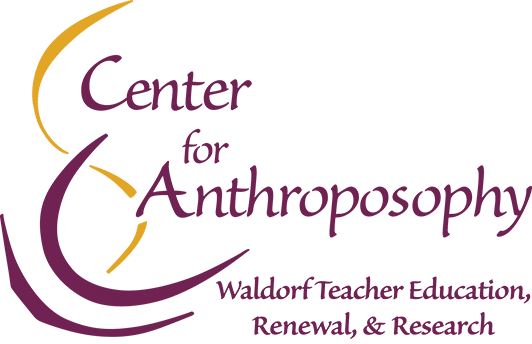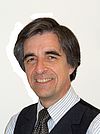 A question: Why do we celebrate birthdays?
A question: Why do we celebrate birthdays?
It was not always so. You don’t have to go far back in history to find that records of birth were kept far less reliably than records of death. In earlier centuries, if they marked it at all, people were more likely to celebrate not their day of birth but rather their day of baptism or some other religious or civic ceremony in their biography. As recently as the mid 1800s one still could have good reason to doubt the accuracy of one’s supposed birth date. For instance, Rudolf Steiner spent a good portion of his life, according to his friends, trying to establish the exact date of his birth. (A separate item in this newsletter offers details of that story.)
In all likelihood, Steiner would not face such uncertainty were he alive in our present age of scrupulous––even exhaustive––record keeping. Indeed, without an accurate and certified record of his birth, he might have great difficulty today getting a job –– or even a driving license.
So why did we not always record birthdays as carefully as death days, and why do we do so today? To be sure, there are practical considerations, but one can point to other reasons, too.
First: consider the fact that, by and large, the moment of death coincides with the departure of consciousness, including most often our self-consciousness. Both events happen at about the same time. That is to say, death means departure of our ‘I’ from residence in the physical body. One cannot say the same for the moment of birth. Our self-consciousness takes quite some time to light up following the arrival of our physical body on earth. In other words, the birth of our ‘I’ happens at a considerable remove from the birth of our living and sentient physical body. To the degree, then, that we attend primarily to our spiritual––rather than to our physical––passage on earth, we will be less likely to bother recording, or preserving, the details of our physical birth, though we may well keep precise records of our death.
A second consideration: What happens when as a culture we start to identify our being, our consciousness––and by extension our self-consciousness––with the existence of our physical body? I would suggest we then begin to keep more accurate records of our physical arrival on earth. Further, we may even begin to ignore those developmental signposts of becoming more fully self-conscious as we become older –– a process that modern brain research suggests lasts well into our 20s.
We do well to celebrate the safe arrival on earth of a new infant, for this day represents a remarkable achievement of all who have participated in that mysterious process. We may ask, however, what accomplishment––and what promise––are we celebrating when we gather round the birthday child and light a candle or two or three or . . . .
This year, around the globe, we are celebrating the 150th birthday of Rudolf Steiner. In this issue of our newsletter Center & Periphery, we report on some of those celebrations, as well as other festivals and milestones connected with his work, and with our own. We invite you to celebrate with us in the reports––and the months––that follow.
Douglas Gerwin, Director
Center for Anthroposophy
Double-click any bullet point below to jump to the article.
In this Issue
Dateline Wilton, NH: Celebrating 150 Years of Rudolf Steiner—early!
 The Center for Anthroposophy stole a march on Rudolf Steiner’s birthday by staging a day of festivities three days before the 150th anniversary of his actual date of birth. Douglas Gerwin reports on how it went and why it happened so early.
The Center for Anthroposophy stole a march on Rudolf Steiner’s birthday by staging a day of festivities three days before the 150th anniversary of his actual date of birth. Douglas Gerwin reports on how it went and why it happened so early.
What better way to mark the birthday of Rudolf Steiner than to host a day filled with stories, art, and social encounters topped off by Kaffee und Kuchen.
The day––Thursday 24 February 2011––began with a series of informal readings and reminiscences of Rudolf Steiner, both in his own words and in the words of those who knew him. About 30 people crowded into the bookstore portion of the Color Shop & More, the store on Main Street Wilton owned by the Center for Anthroposophy, to hear four presenters offer vignettes of Steiner’s life, starting with his childhood in the Austro-Hungarian village of Kraljevec. Torin Finser, Chair of the Education Department at Antioch University New England, read from Steiner’s autobiography and passed around photos and maps depicting Steiner’s life, especially during his early years as the son of a railway station master in Southern Austria and later as a university student in the cultural hub of Vienna.
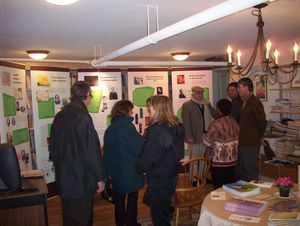 Alice Groh, a familiar name in Waldorf and anthroposophical circles, picked up the story with Steiner’s early adult years as writer, editor, and artist first in Weimar then in Berlin, which in the late 19th century was a throbbing capital of radical new ideas in politics, philosophy, art, literature, drama, and music. Alice pointed out that at this stage in his life, Steiner was engaged primarily in reaching out and mingling with the most avant garde movements of his time. Only later would he begin to offer his own contributions in these fields.
Alice Groh, a familiar name in Waldorf and anthroposophical circles, picked up the story with Steiner’s early adult years as writer, editor, and artist first in Weimar then in Berlin, which in the late 19th century was a throbbing capital of radical new ideas in politics, philosophy, art, literature, drama, and music. Alice pointed out that at this stage in his life, Steiner was engaged primarily in reaching out and mingling with the most avant garde movements of his time. Only later would he begin to offer his own contributions in these fields.
It fell to Milan Daler, Administrator of the Center, to orient the story to Steiner’s more philosophic and religious pursuits, including his response to a circle of young German Lutheran ministers that resulted in a renewal of religious practice now known around the world as the Christian Community. In the field of curative education, Milan recounted how Karl Koenig, one of the founding physicians of the international Camphill Movement for handicapped children, came within a few blocks of the stock exchange building in Vienna, where Steiner was giving an important series of lectures. For some reason, Koenig turned back and so never got to hear or meet Steiner –– a decision he regretted lifelong.
Finally, Margaret Chambers, who with Alice has been active for years in the anthroposophical studies in Wilton and around the country, steered the conversation into the more esoteric subjects that occupied Steiner during his final years at the Goetheanum, a building he designed and helped to build in Dornach just south of Basel, Switzerland, during the First World War.
After a break in the schedule of festivities, the scene shifted from the rear of the Color Shop & More to the reading room of the Cadmus Library, an anthroposophical lending library located in the basement of the store. There Douglas Gerwin, Director of the Center, introduced to an audience of around 30 participants an hour-long TV documentary on the life and work of Rudolf Steiner. Douglas drew attention to the roughly dozen areas of science and the arts, politics and education, medicine and agriculture, religious practice and social reform, scholarly research and practical guidance in which Steiner was active during the course of his adult life. In introducing the film, Douglas pointed to the international reach of Steiner’s influence –– made evident by the many strange foreign accents of those interviewed in English for the film, which was shot both in Europe and the United States.
Arranged around the reading room were five elegant floor-to-ceiling panels depicting highlights of Steiner’s contributions to the subjects explored in the film. The panels, part of a traveling exhibition mounted by the Anthroposophical Society in America, remained on display for the remainder of the day, culminating in a guided tour of them by Arthur Auer, Director of the Waldorf Teacher Education Program at Antioch University.
For the final event of the day, the festivities shifted from the Library next door to the Wilton Main Street Café, where Karine Munk Finser, Coordinator of the Center’s Renewal Courses, had arranged an art display and evening buffet reception for over 30 guests. Here several speakers shared stories both humorous and poignant of those who knew Steiner at first hand. In between these remarks, Steiner’s birthday was celebrated in song, while portions of a large white birthday cake were distributed along with mugs of coffee and tea.
Among the speakers were Arthur Auer on the sculptural forms embedded in the Goetheanum building, Karine Munk Finser on Steiner’s use of “daytime” and “nighttime” colors, Trauger Groh on his family’s personal reminiscences of Rudolf Steiner, Douglas Gerwin on the growth of Waldorf Education worldwide, and Bertram von Zabern, MD, on recollections of the initial group of young physicians who studied homeopathic medicine with Steiner. Excerpts of these remarks can be viewed here.
To end the evening, Torin Finser read a verse he had written in appreciation of Rudolf Steiner’s myriad contributions, many of which are gradually finding their way into the mainstream of modern culture.
To learn why the Center celebrated Steiner’s birthday three days early, click on the next article (below).
Arthur Auer speaks about Rudolf Steiner’s biography
Torin Finser introduces the R. Steiner 150th birthday festivities
Douglas Gerwin speaks at R. Steiner 150th birthday celebration
Dateline Kraljevec: So When Exactly Was Rudolf Steiner Born?
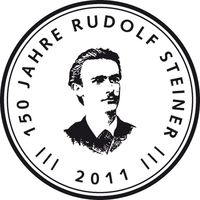 As Rudolf Steiner’s 150th birthday was being celebrated around the world, questions resurfaced about the precise date of his birth. With the help of a European researcher, new evidence tells an interesting story. Here is a summary of this research.
As Rudolf Steiner’s 150th birthday was being celebrated around the world, questions resurfaced about the precise date of his birth. With the help of a European researcher, new evidence tells an interesting story. Here is a summary of this research.
In his autobiography Rudolf Steiner lists 27 February 1861 as his birthday, and that should be the end of the matter. However, at his time, it was the convention to give one’s date of baptism as one’s official birthday, which usually occurred two days after one’s physical arrival upon earth. Therefore, it could be assumed that Steiner was actually born on 25 February, and indeed there is some record of this being the case.
However, a couple of years ago a researcher named Guenther Aschoff went back through the register of births and baptisms and discovered that Steiner (or more precisely Steiner’s mother) had endured a very difficult and long birth lasting well over a day or so, and for this reason members of his Catholic family, feeling concern about the infant’s wellbeing, had asked for an emergency baptism to be performed on the day of his actual birth. And so it was, that Steiner was both born and baptized on the 27th (though he may also have received a second and more “formal” baptism two days later).
This story has a further wrinkle. In the registry of baptisms, Rudolf Steiner’s name is inscribed as the 25th on the list. Some historians took this number as being the date of his birth, rather than his place in the registry, given that his (initial) baptism was conducted on the 27th. According to T.H. Meyer, author of Rudolf Steiner’s Core Mission: The Birth and Development of Spiritual Scientific Karma Research (Temple Lodge, 2010), Steiner spent a good portion of his life not knowing the exact date of his birth, and he even consulted his younger sister about the matter.
Dateline Ann Arbor, MI: Steiner’s Life and Work Encapsulated
In connection with this anniversary, the Anthroposophical Society in America published the following succinct summary of Steiner’s life and influence:
The year 2011 is being celebrated worldwide as the 150th anniversary year of the birth of Rudolf Steiner (1861-1925), the Austrian-born scientist, philosopher, educator, esotericist, artist, holistic thinker, and social activist.
Steiner was born to a working class couple on 27 February 1861 in Kraljevec, Austria-Hungary, now Donji Kraljevec, Croatia. Steiner’s life work has been characterized as the “many-sidedness of an outsider.” Its influence today, however, is worldwide, and seems only to be growing:
- Waldorf and Rudolf Steiner schools number over a thousand worldwide, on every continent; Waldorf parent and Nobel peace prize winner Willy Brandt called it the most important contribution to world peace of the 20th century.
- Biodynamic agriculture, along with the organic agriculture movement it helped to inspire, is likewise spreading on farms and recently also vineyards worldwide, combining an intense ecological consciousness with radical conceptions of human nutrition and the livingness of the Earth.
- Steiner’s direct and indirect influence in the arts (through such figures as Wassily Kandinsky, Josef Beuys, Andrei Bely, and Michael Chekhov) is being recognized more widely, including two major exhibits 2010-2011 in Europe.
- Steiner-inspired communities have exhibited diverse social innovation in diverse cultures including Israel and Egypt, pre-apartheid South Africa, India, and South America; outstanding among them is the Camphill movement centered on special needs and gifts.
- Economic and social ideas pioneered or inspired by Steiner continue to receive attention and to influence social-impact investing and tri-sectoral social leadership.
- Steiner launched an impulse in complementary medicine in the 1920s which is now well-established in Europe and represented in many other parts of the world.
- Steiner’s fundamental ideas about human and cultural evolution continue to be rediscovered, reconsidered, found relevant and even still “avant-garde.” Documentary filmmaker Jonathan Stedall, who made films for the BBC on Tolstoy, Gandhi, and C.G. Jung, is at work on “The Challenge of Rudolf Steiner” to be released in late 2011.
Rudolf Steiner worked independently until the late 1890s when he became a popular lecturer at Berlin’s socialist workers school. A few years later he was asked to head a German section of the Theosophical Society, and he was also designated leader of its esoteric school. In 1913 this relationship ended and the Anthroposophical Society was founded. This became the main vehicle for Steiner’s work from that time forward.
The first and second Goetheanum buildings in Dornach near Basel, Switzerland, both designed by Steiner, are important architectural landmarks of 20th century Europe. The first burned at the end of 1922; the second remains the international center of the Anthroposophical Society.
Two years before his death, Steiner described the path to becoming an anthroposophist as recognizing with one’s heart that the world and one’s own life is not as it should be; then seeking with the mind a higher standpoint and knowledge from which to understand the situation; and then taking action in the world. In 1999 the book The Cultural Creatives described the same sequence as the personal developmental path of tens of millions of people worldwide.
In this country there are several hundred early childhood initiatives and independent Waldorf schools, as well as a growing number of Waldorf-inspired charter schools. The Anthroposophical Society recognizes several dozen branches and groups. Biodynamic farms and vineyards are found from coast to coast, along with Camphill Villages and other Steiner-inspired social communities.
Dateline Ann Arbor, MI: Torin Finser Goes Another Round
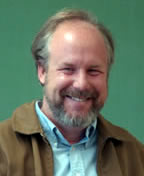 Torin Finser has been re-appointed as General Secretary of the Anthroposophical Society in America. A brief announcement describes some changes in his responsibilities.
Torin Finser has been re-appointed as General Secretary of the Anthroposophical Society in America. A brief announcement describes some changes in his responsibilities.
Under the bylaws of the Anthroposophical Society in America, a general secretary may serve for up to three terms––of four, three, and three years respectively––for a total of 10 years.
Torin Finser, Chair of the Education Department at Antioch University New Hampshire and a member of its Waldorf Teacher Education Program, has been re-appointed to a second term after his current term ends in October of this year. However, he will assume sole responsibility as general secretary in that MariJo Rogers, who has served as co-general secretary with Torin for the past four years, is not seeking re-appointment. Although the Society has in the past benefited from having two members share these responsibilities, the General Council of the Society decided to go forward as of next October with just one general secretary.
Dateline Chicago, IL: Preparing Teachers for the Classroom
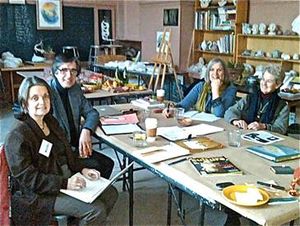 As a follow-on to a colloquium of Waldorf teacher educators, a group of four Waldorf adult educators was commissioned to formulate ideas on the preparation of teachers for the classroom. Dorit Winter, one of the four asked to join this group, reports on their first round of deliberations.
As a follow-on to a colloquium of Waldorf teacher educators, a group of four Waldorf adult educators was commissioned to formulate ideas on the preparation of teachers for the classroom. Dorit Winter, one of the four asked to join this group, reports on their first round of deliberations.
During last January’s Colloquium of Teacher Educators, organized by the Teacher Education Network (TEN) of AWSNA, a committee of four members from the Network was formed. The committee, pictured below, includes left to right: Patrice Maynard (AWSNA), Douglas Gerwin (Center for Anthroposophy), Frances Vig (Chicago Waldorf School), and Dorit Winter (Bay Area Center for Waldorf Teacher Training). The group was asked to harness the enthusiasm and major themes of the colloquium. Could new impulses for Waldorf teacher training in North America be identified? Could practical ways to implement such new impulses be found?
After several fruitful telephone conference calls, the committee met in Chicago for a day and a half on 28 February and the morning of 1 March. Lucky to be meeting in the sculpture room of the Chicago Waldorf High School, welcomed and cared for by the school’s sculpture teacher Frances Vig, the four participants were able to knead and shape two major topics: how to alter and enhance the relationship of teacher education institutes and the Waldorf schools they serve; and how to improve the efficacy of the Teacher Education Network itself.
To inspire our conversation, we started each of our three sessions with thoughts and conversation inspired by Rudolf Steiner’s potent lecture about signs of the times, The Work of the Angels in Man’s Astral Body.
Meeting for a full day from 8:30 a.m. until 6:00 p.m. on Monday, including conversations over meal times, the committee arrived at a proposed pilot project in the realm of teacher training practicum or apprenticeship. This proposal will be considered by the Teacher Education Network in its next conference call.
The second topic considered by the group of four, namely how to re-think the Teacher Education Network, will require further consideration.
All in all, a lot of good work took place. The group grappled with the material, turned it over, worked it through. Some air bubbles remain in the shapes that were formed, which means they are not yet entirely ready to be put in the kiln and fired, but their contours have been clarified. Specific proposals can be expected during the coming months.
Dateline Wilton: Line-up for Renewal Courses in 2011
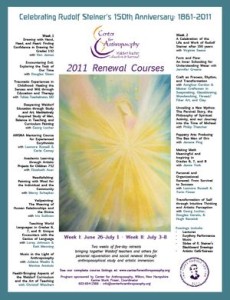 This year will mark several “firsts” for the Center’s annual Renewal Courses of five-day intensives. Karine Munk Finser, Coordinator of Renewal Courses, reports on prospects for a busy and star-studded summer.
This year will mark several “firsts” for the Center’s annual Renewal Courses of five-day intensives. Karine Munk Finser, Coordinator of Renewal Courses, reports on prospects for a busy and star-studded summer.
This summer we will dedicate our Renewal Courses to celebrating the 150th birthday of Rudolf Steiner, born in 1861. In this context, we will be hosting Virginia Sease from the leadership of the School for Spiritual Science at the Goetheanum in Dornach, Switzerland. She will offer a five-day course on “The Life and Work of Rudolf Steiner” including elements of her research on the theme of initiation and the New Mysteries.
Among other first-time appearances at our Renewal Courses:
- Douglas Sloan, professor emeritus at Teachers College Columbia University, will tackle the contemporary topic of the encounter with evil and its transformation
- Philip Thatcher, General Secretary of the Anthroposophical Society in Canada, will take up the interrelationships between the Medieval epic Parzival and Rudolf Steiner’s Philosophy of Spiritual Activity
- Jennifer Greene, director of the Water Research Center in Blue Hill, Maine, will explore the cosmic forces that flow through water
- Tobias Tuechelmann, MD, an active member in the annual International Therapists Conferences In Dornach, will examine traumatic experiences in childhood, drawing upon recent developments in neuroscience and child psychiatry
- Van James, celebrated author and high school teacher from Hawaii, will offer a drawing course based on the Waldorf curriculum, grades 1-12, as well as elements from his latest book
- Marcy Schepker will inaugurate a new workshop in needlefelting to create wall hangings for the classroom and the community
Several leading faculty members will be returning next summer with courses new to Renewal. Among them:
- Christof Wiechert, outgoing leader of the Pedagogical Section at the Goethenum, will present a new course on the health-bringing aspects of the Waldorf curriculum and the teachers’ approach to education
- Aonghus Gordon, along with his team of five expert craftsmen from Ruskin Mill in England, will lead a further installment of work through the crafts of glass blowing, clay, woodwork, thread/fibre crafts, and soapmaking
- Janene Ping will return with a new course of marionette and shadow puppet theater, focusing upon a contemporary fairy tale, “The Bee Man of Orn”
- Georg Locher will invite teachers to work on two key texts by Rudolf Steiner, Balance in Teaching and Study of Man, with an accompanying immersion in wet-on-wet and veiling techniques in painting for grades 6-8
- Elizabeth Auer will help participants create armfuls of delightful projects arising from the Waldorf crafts curriculum for children aged 7-12
- Iris Sullivan returns this year with a course on veilpainting to school both professional artist and untrained apprentice alike.
Beyond this array of workshops, there will be evening lectures, a professional eurythmy performance to celebrate Rudolf Steiner, as well as our usual artistic soirees.
The first series of these courses run from Sunday 26 June through Friday 1 July 2011; the second week from Sunday 3 July through Friday 8 July 1011.
Consult the Center’s website (centerforanthroposophy.org) for a complete listing of courses in our Renewal Courses 2011 brochure. We encourage early registration since we expect this summer to be busy and our beautiful site on the campus of High Mowing School in Southeastern New Hampshire has a limited number of single and double rooms!
We look forward to seeing many of you this summer.
Dateline Spring Valley, NH: Renewal Through Eurythmy
 Eurythmy Spring Valley troupe makes a special appearance at the summer Renewal Courses in Wilton, NH. Get a sneak preview here of their program.
Eurythmy Spring Valley troupe makes a special appearance at the summer Renewal Courses in Wilton, NH. Get a sneak preview here of their program.
“Eurythmy Spring Valley” will perform in the Pine Hill Auditorium on the evening of July 5th, during the second week of our Renewal Courses. The special program, dedicated to Rudolf Steiner, will feature pieces of both tone and speech eurythmy.
It is our intention to open our doors to share this artistic event with community members and friends. Tickets, at $12.00, can be purchased at the door or reserved by calling the CfA office at (603) 654- 2566.
